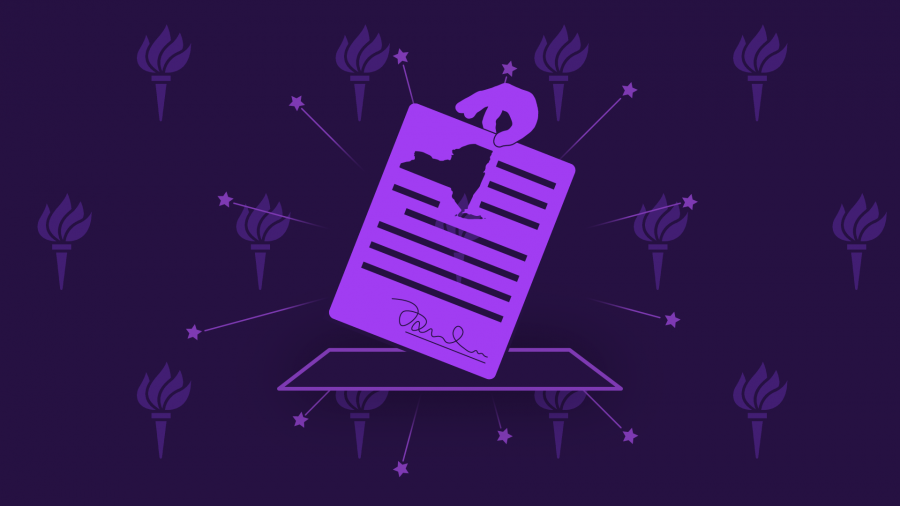On Nov. 8, 2016, two New Yorkers faced off in one of the most contentious presidential elections in U.S. history, resulting in the election of Queens-native Donald Trump. Tuesday’s election will provide Americans with their biggest opportunity yet to protest the actions of a historically unpopular president as the Democratic Party is projected to retake the House.
Though few local races appear hotly contested, NYU’s size and prestige grant it significant influence in both city and state-wide races. This Tuesday, thousands of NYU students, faculty and staff will take to the polls throughout New York City to exercise their civic duty and hold their leaders accountable.
NYU Community
Over the past few months, politically-minded students at NYU have been holding phone banking sessions and hosting keynote speakers in hopes of energizing their peers. On Tuesday, they’ll see if their hard work paid off.
With Republicans currently in control of the White House, Senate and the House of Representatives, many Democrats, like CAS sophomore and College Democrat Secretary Arman Becan, are hoping for a blue wave at the polls.
“We are sick and tired of all the pain and suffering this Congress and administration have caused,” Becan said. “We are confident that a majority of Americans agree with us.”
Research shows that higher voter turnout helps Democrats, while lower turnout gives Republican candidates a boost. If the statistic is consistent, a blue wave is surely on the rise.
Bennett Kauffman, a CAS sophomore and vice president of the College Republicans, recognized the Democrats’ momentum but does not see them taking over the house.
“I’m expecting Republicans to lose seats in the House but not enough to lose the majority,” Kauffman said. “I think we’ve seen a very energized Democratic base, but the early voting numbers show large Republican turnout as well. I’m expecting most of the races to be close, but I think Republicans should hold the house.”
Meanwhile, some students are looking beyond Democrats and Republicans altogether. College Libertarians Social Media Coordinator Hermi Wang is holding out hope for an end to the system of two major political parties, throwing her support behind New York Libertarian gubernatorial candidate Larry Sharpe instead.
“What I hope to see in the midterms is not necessarily the victory of a certain party,” Wang said. “I want to see voters voting for the candidate who they think is most fit for the job rather than the candidate who has a better chance at winning but isn’t necessarily the best.”
Regardless of the outcomes of Tuesday’s elections, College Democrats Political Director Ethan Arsonge wants people to stay politically engaged on the other 364 days of the year as well.
“While all the attention is on Tuesday, I hope NYU students continue to keep up with the news after the election and make sure that candidates they vote for follow through in the promises they made,” Arsonge said.
State and Local Races
Governor/Lieutenant Governor
Governor Andrew Cuomo is looking to be re-elected for his third term on Tuesday. With a convincing 13 point lead in a poll done by Siena College on Sunday, it seems likely. Dutchess County Executive Marc Molinaro is the Republican candidate and is running on a platform of cutting property taxes and reducing county costs through decreasing mandates on localities.
Cuomo has not signaled any plans for a third term besides making comments on preserving abortion rights through legislation and increasing the strictness of gun laws. Rumored to be a potential 2020 presidential candidate, Cuomo has insisted he will serve as governor for all four years if re-elected. Cuomo is running with his current Lieutenant Governor Kathy Hochul, who narrowly beat challenger Jumaane Williams in the primary and faces off against Republican Julie Killian.
Attorney General
Cuomo-backed Letitia “Tish” James, the city’s public advocate, faces off against Republican Keith Wofford for attorney general. James initially introduced a platform around criminal justice reform and has been outspoken on her willingness to prosecute President Donald Trump and his policies. Eric Schneiderman, who formerly held the position before stepping down in light of physical abuse accusations, was also vocal about the possibility of prosecuting Trump.
A corporate lawyer, Wofford has promised to go after corruption, making Cuomo a person of interest after his aide, Joseph Perocco, was found guilty in a corruption trial. Wofford says he would put less pressure on Trump than James and decrease prosecution of Wall Street in comparison to previous attorney generals.
James is in the lead, polling at 49 percent compared to Wofford’s 37 percent. James would be the first black woman to hold the position in New York’s history.
Senate
Potential 2020 presidential candidate Kirsten Gillibrand leads Republican Chele Chiavacci Farley in the senate race by a large margin. A Quinnipiac University poll in mid-October had Gillibrand at 58 percent compared to a mere 33 percent for Farley. Despite the polls, the Republican candidate still has faith, comparing her campaign to that of Alexandria Ocasio-Cortez, who won an upset victory in the primaries over incumbent Joseph Crowley. Farley is a private-equity executive who is supported by President Trump.
Meanwhile, Gillibrand has largely ignored her opponent, campaigning for other Democrats around the country and spending little money on her own race, suggesting she may be preparing for a run in 2020.
U.S. House of Representatives
NY-10
Democratic incumbent Rep. Jerrold Nadler will face Republican Naomi Levin to represent New York’s 10th congressional district, which encomposses most of NYU’s Washington Square Park and Tandon campuses. Nadler was first elected to the House in 2013.
Currently, Nadler is the ranking member of the House Judiciary Committee, and if the Democrats win the House, he will become the chair of the committee. He has spoken of opening an investigation into Supreme Court Justice Brett Kavanaugh over sexual misconduct allegations if he is elected.
So far, the race has not been competitive — with a forecast suggesting that Nadler has 99 percent chance of winning.
NY-12
Republican Eliot Rabin and Green Party candidate Scott Hutchins are running against Democratic incumbent Rep. Carolyn Maloney to represent New York’s 12th congressional district, which represents parts of the Washington Square Park and Tandon campuses.
A recent FiveThirtyEight forecast shows Maloney with a 99 percent chance of winning reelection.
NY-8
In New York’s 8th congressional district, Democratic incumbent Rep. Hakeem Jeffries will face Conservative Party candidate Ernest Johnson and Reform Party candidate Jessica White. No Republican candidate is running for the seat. The 8th district represents parts of the Tandon School of Engineering’s campus.
With no other major party nominee, FiveThirtyEight predicts that Jeffries has at least a 99 percent chance of winning this Tuesday.
Jeffries has been eyed as potential House Speaker pick. The Congressional Black Caucus wants one of its members to potentially take the position in the event that Democrats have a majority after the elections. If Jeffries becomes Speaker of the House, he will be the first black speaker.
Ballot Initiatives
Outside of elected candidates, New York City voters alone will have the opportunity to weigh in on three ballot initiatives. A ballot initiative is a question, proposed by a government official or a constituency of voters, seeking to use a popular vote to revise, create or eliminate an existing law.
Following six months of public hearings about possible changes to the New York City Charter, the city has spent more than $1 million on public awareness campaigns about the initiatives, all of which are supported by Mayor Bill de Blasio.
Initiative One: Reducing the amount of money donors can give to political campaigns
This initiative aims to increase the city’s matching-funds program, which helps candidates rely on city residents rather than large donors to fund their campaigns. Currently, the program matches small contributions from New York City residents at a $6-to-$1 rate. If passed, it would match them on an $8-to-$1 rate, increasing the cost of the program by about 47 percent. Additionally, donor contributions would be restricted from $5,100 to $2,000 for the mayor and $3,950 to $1,500 for city council members.
Initiative Two: Instituting a Mayoral Civic Engagement Commission
If passed, this initiative would create a “Civic Engagement Commission” comprised of 15 members appointed by the mayor. Its aim would be to increase participation in the democratic process by means of placing translators at voting sites and providing resources to community boards.
Some say this commission is unnecessary because it would duplicate other government systems already in place. One such system is borough presidents’ offices, which already appoint community board members and provide them with resources.
Initiative Three: Setting Term Limits for Community Board Members
The third ballot initiative would set four consecutive two-term limits for New York City community board members. Mayor de Blasio frames the initiative as a means of creating more turnover between community board members, to diversify voices which have an effect on local issues and to involve more young people on community boards.
Though supported by de Blasio, the initiative remains opposed by each of New York City’s borough presidents with the exception of Brooklyn Borough President Eric Adams. Those arguing against the initiative claim it would cede more power to local land developers, because it would force out the board members with the most experience and influence.
A version of this article appeared in the Monday, Nov. 5 print edition. Email the news desk at [email protected]

























































































































































Dennis • Nov 5, 2018 at 6:09 pm
Larry Sharpe is by far the best choice for Governor of New York. Just Google his name or find him on Youtube – there are tons of videos.